The world of coupons is booming, and if you are not using them, you are missing out on significant savings!
In 2025, coupons are more than just paper slips; they are powerful digital tools that influence how we shop, what we buy, and how much we save.
This article dives deep into the latest coupon statistics 2025, showing you exactly how coupons work, why they are so popular, and how you can use them to your advantage.
Get ready to become a savvy shopper!
Contents
- 1 The Coupon Craze: Why Everyone is Using Them
- 2 How Many People Are Truly Embracing Coupons?
- 3 The Power of Digital: How Effective Are These Online Discounts?
- 4 Redemption Rates: How Often Do People Use Coupons?
- 5 The Growing Coupon Market: A Look at the Numbers
- 6 How Often Do People Use Digital Coupons?
- 7 How Much Time Do We Spend Hunting for Deals?
- 8 Where Do Consumers Find These Valuable Coupons?
- 9 How Much Money Do Coupons Actually Save Consumers?
- 10 Who Uses Coupons? A Look at Demographics
- 11 The Mobile Revolution: Device Usage for Coupon Redemption
- 12 Digital vs. Paper: The Shifting Landscape
- 13 The Influence of Coupons on Shopping Behavior
- 14 Where Do People Find the Best Coupon Deals?
- 15 Social Media: A Hub for Coupon Discovery
- 16 What Users Are Asking on Quora and Reddit (Latest Information):
- 17 FAQs About Coupon Statistics
- 17.1 1. Why have digital coupon redemption rates increased since 2008?
- 17.2 2. How much money can an average American household realistically save annually by using online coupons?
- 17.3 3. What is the most effective way for me to find reliable digital coupons in 2025?
- 17.4 4. How do coupons influence my purchasing decisions beyond just saving money?
- 17.5 5. Are paper coupons still relevant for certain demographics or shopping scenarios in 2025?
- 17.6 Conclusion:
The Coupon Craze: Why Everyone is Using Them
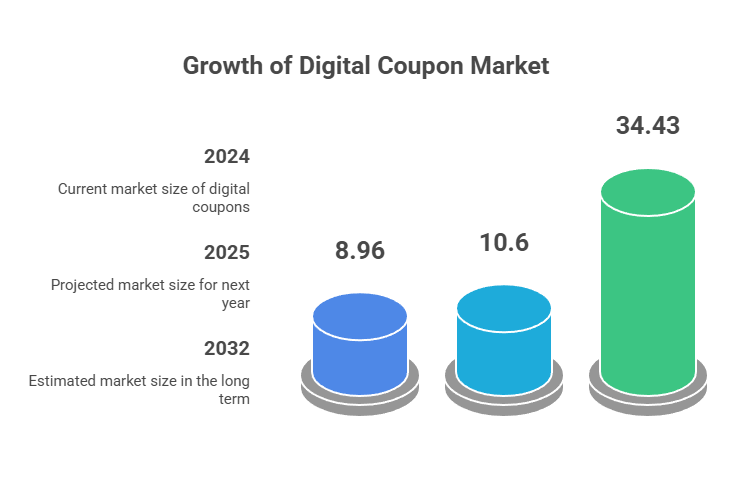
Coupons are not a niche trend; they are a mainstream shopping strategy. Nearly 90% of consumers in the U.S. have used a coupon at some point, and a significant 62% actively search for promo codes and discounts when shopping online.
This shows a clear desire among shoppers to save money wherever possible. The digital age has made couponing easier than ever, with smartphones becoming our personal discount detectives.
The growth of the digital coupon market is truly impressive. In 2024, the global digital coupon market stood at a robust $8.96 billion. This number is not just sitting still; experts project it to soar past $10.6 billion in 2025 and reach an astonishing $34.43 billion by 2032.
This incredible growth, with a compound annual growth rate (CAGR) of 18.33% from 2023 to 2032, proves that digital coupons are here to stay and will only become more integrated into our shopping habits.
Key Coupon Insights for 2025:
- Widespread Use: Almost 90% of U.S. consumers have experienced the joy of using a coupon.
- Online Search: 62% of U.S. shoppers actively look for promo codes and coupons when they shop online.
- High Redemption: Digital coupons boast an average redemption rate of 7% or even higher, showcasing their effectiveness.
- Digital Dominance: Digital coupons now make up one-third of all coupon redemptions, making them the most popular type.
- Market Boom: The global digital coupon market is on track to hit $10.6 billion in 2025.
- Quick Search: Most consumers (34%) spend about 5 to 10 minutes finding a coupon, highlighting the need for easy access.
- Mobile First: About 40% of shoppers use their smartphones to find discounts while they are actually in a store.
How Many People Are Truly Embracing Coupons?
Millions of people are actively seeking out and using coupons. In the United States, 62% of consumers routinely search for and use promo codes, discounts, and coupons when they shop online. If we look at the broader picture, nearly 90% of U.S. consumers have used a coupon at some point in their lives.
Looking at recent trends, 850 million coupons were redeemed in 2023, which was a 10% jump from the previous year. A remarkable half of these redemptions came from digital coupons, while traditional insert coupons accounted for a mere 7%. This clearly indicates a significant shift towards digital methods.
When people want to find deals, Google is their go-to, with 59% of shoppers using it to search for discounts. Popular coupon sites like RetailMeNot attract 46% of shoppers, and 41% prefer to use retailer-specific apps or websites directly.
The Power of Digital: How Effective Are These Online Discounts?
Digital coupons are incredibly effective, and businesses are taking notice. A strong 64% of retail media decision-makers in the U.S. see digital coupons as a highly effective tool for driving sales.
Even more telling, 67% of brand advertisers in the U.S. consumer packaged goods sector believe that both digital and physical coupons will be crucial in their future retail media strategies. This means businesses are investing in coupons because they work.
- Also read about: Latest Digital Marketing Statistics
Redemption Rates: How Often Do People Use Coupons?
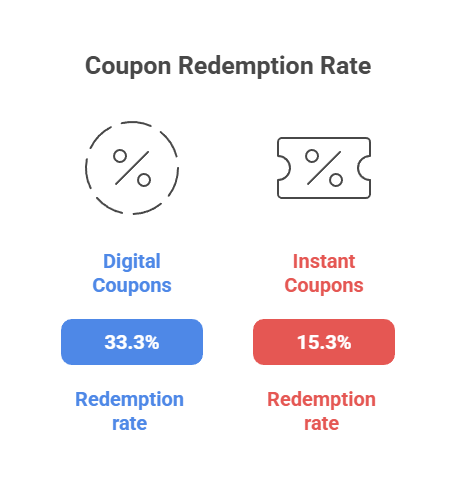
The average redemption rate for a digital coupon is an impressive 7% or even higher. This marks a positive change, as redemption rates have increased since 2008, suggesting that more people are actively looking for and using coupons.
Digital coupons are leading the pack, making up a significant one-third of all coupon redemptions. Instant redeemable coupons, on the other hand, are the least popular, accounting for just 15% of the total.
Coupon Redemption Rate by Type:
| Coupon Type | Redemption Rate |
| Digital Coupons | 33.3% |
| Free Standing Insert (FSI) | 24.2% |
| Instant Redeemable Coupons | 15.3% |
| Other | 27.2% |
While the general coupon redemption rate can hover around 0.9%, successful digital campaigns often achieve 7% or more, proving that well-targeted and easily accessible digital coupons truly resonate with consumers.
Mobile coupons, for example, are redeemed about 10 times more often than paper coupons due to their convenience.
- Also read about: Mobile Internet Traffic Statistics
The Growing Coupon Market: A Look at the Numbers
The global digital coupon market is experiencing robust growth. It was valued at $7.57 billion in 2023 and has steadily climbed to $8.96 billion in 2024. This trend is set to continue, with projections showing the market reaching $10.6 billion in 2025.
By the end of 2032, this market is expected to exceed $34.43 billion. This significant growth highlights the increasing adoption of digital coupons and their vital role in how consumers make purchasing decisions.
Estimated Digital Coupon Market Size by Year:
| Year | Digital Coupon Market Size |
| 2023 | $7.57 billion |
| 2024 | $8.96 billion |
| 2025* | $10.6 billion |
| 2026* | $12.54 billion |
| 2027* | $14.84 billion |
| 2028* | $17.56 billion |
| 2029* | $20.78 billion |
| 2030* | $24.59 billion |
| 2031* | $29.1 billion |
| 2032* | $34.43 billion |
Source: eMarketer
*-projected values
How Often Do People Use Digital Coupons?
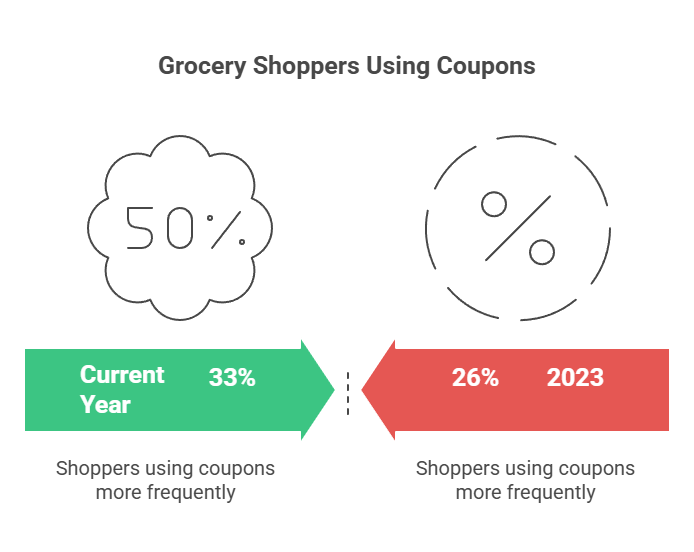
People are using coupons more than ever, especially for groceries. In the current year, 33% of U.S. grocery shoppers report using coupons more frequently, up from approximately 26% in 2023. This shows a growing reliance on coupons for everyday essentials.
More than half (51%) of online shoppers in the U.S. occasionally use coupons, while 22% use them almost every time, and 14% always use them. This demonstrates that for many, coupon usage is a regular part of their online shopping routine.
Frequency of Digital Coupon Usage by Online Shoppers in the U.S.:
| Frequency of Digital Coupon Usage | Percentage of Online Shoppers |
| Occasionally | 51% |
| Almost every time | 22% |
| Always | 14% |
| For half of purchases | 13% |
Source: Statista
When it comes to the types of coupons people prefer, “percentage-off” coupons are the clear favorite, with 67% of shoppers choosing them.
“Buy one, get one free” (BOGO) coupons are also very popular, preferred by 61% of consumers. Free shipping comes in third, with 57% of consumers favoring it.
Most Preferred Coupon Types by Shoppers:
| Type of Coupon | Preferred by Percentage of Consumers |
| Percentage off | 67% |
| Buy one, get one free | 61% |
| Free shipping | 57% |
| Fixed amount off | 48% |
| Other | 1% |
One common question is how often digital coupons actually work. For 50% of people, half of the digital coupons they find online work only 10-50% of the time.
However, 9% of shoppers report that digital coupons found online work over 90% of the time. This highlights the importance of reliable coupon sources.
Success Rate of Digital Coupons Found Online:
| The Success Rate of Coupon | Share of Online Shoppers |
| Less than 10% of the time | 14% |
| 10-30% of the time | 26% |
| 30-50% of the time | 24% |
| 50-70% of the time | 17% |
| 70-90% of the time | 10% |
| Over 90% of the time | 9% |
How Much Time Do We Spend Hunting for Deals?
Most consumers (34%) typically spend about 5 to 10 minutes looking for a coupon. This suggests that people want quick and easy access to discounts.
However, a small but dedicated group, about 2% of shoppers, will spend over an hour searching for the perfect deal! This shows the varying levels of commitment people have to finding savings.
Time Spent by Consumers Searching for Digital Coupons:
| Time Spent Searching For A Coupon | Percentage Of Consumers |
| Less than 5 minutes | 26% |
| 5 to 10 minutes | 34% |
| 10 to 20 minutes | 20% |
| 20 to 30 minutes | 12% |
| 30 to 40 minutes | 4% |
| 40 to 50 minutes | 2% |
| More than one hour | 2% |
Where Do Consumers Find These Valuable Coupons?
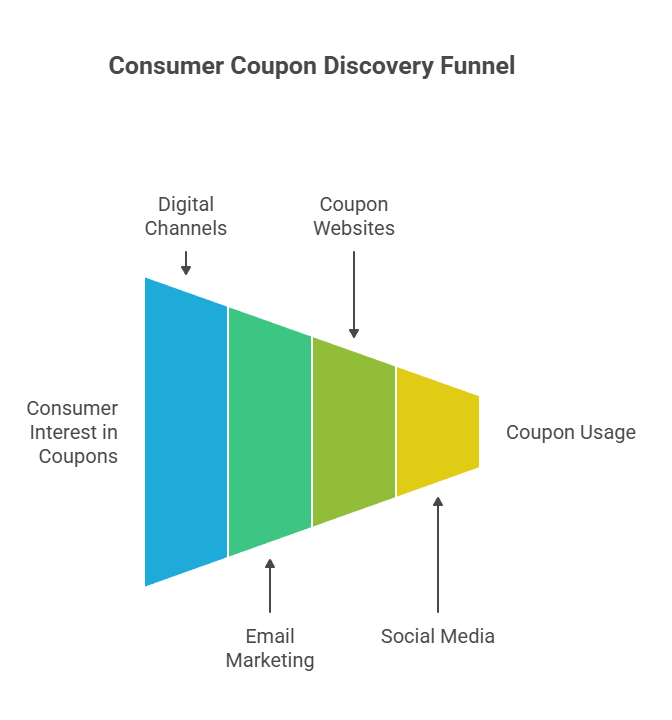
We find coupons in many different places, but digital channels are becoming increasingly important. About 40% of shoppers use their smartphones to search for discounts and coupons while they are actually shopping in a physical store. Furthermore, 35% of U.S. consumers access or download digital coupons while in-store.
Email marketing plays a huge role, with almost half of consumers discovering coupons through emails from brands. Online searches account for another 46% of deal discoveries, and about a third of consumers turn to dedicated coupon websites. Interestingly, social media influencers are a growing source, with 13% of consumers finding coupons through them.
How Consumers Find Coupons:
| Coupon Source | Percentage of Consumers |
| Emails from Brands | 47% |
| Online Searches | 46% |
| Coupon Websites | 34% |
| Coupons from previous purchases | 33% |
| Emails from coupons/deal aggregators | 28% |
| Mail Catalogues/ Flyers | 22% |
| Social Media Posts from Brands | 21% |
| Browser Extensions | 21% |
| Social media paid ads | 16% |
| Social Media Influencers | 13% |
| Podcast Advertising/ Sponsorships | 7% |
- Also read about: Social Media Statistics
How Much Money Do Coupons Actually Save Consumers?
The savings from coupons can add up significantly! A 2021 study by CouponFollow revealed that the average American household could save as much as $1,465 annually by using online coupons. That’s a substantial amount that can make a real difference in a household budget.
Here’s a breakdown of where those savings come from:
- Food at home: $316
- Household Items: $272
- Eating Out: $264
- Entertainment: $160
- Automotive: $138
- Apparel and accessories: $135
- Personal care and beauty: $66
- Alcohol: $47
- Travel: $37
- Tobacco & Smoking: $26
- Reading: $5
While individual savings vary, more than one-third of consumers save between $10 and $25 using digital coupons each month. Almost 3 in 10 save under $10. Only 4% of U.S. shoppers manage to save over $100 through coupons monthly, showing that consistent, smaller savings are more common.
Monthly Savings from Coupons:
| Monthly Savings | Percentage Of Consumers |
| Less than $10 | 29% |
| $10 – $25 | 35% |
| $25 – $50 | 23% |
| $50 – $100 | 9% |
| Over $100 | 4% |
Who Uses Coupons? A Look at Demographics
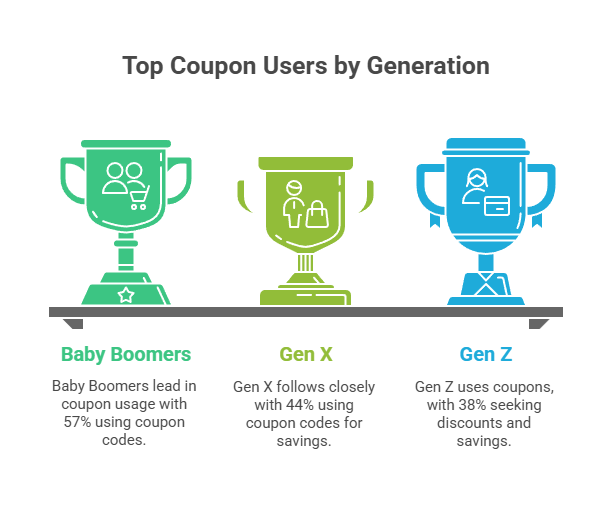
Coupon usage varies across generations, but it is clear that almost everyone is looking for a deal. In the first quarter of 2023, over a third of Millennials and 38% of Gen Z shoppers used coupons or discount codes to save money, often in response to inflation. Baby Boomers are even more active, with nearly 6 in 10 using coupon codes.
Coupon Usage by Generation:
| Generation | Use Coupon Codes/ Discount Codes |
| Gen Z | 38% |
| Millennials | 33% |
| Gen X | 44% |
| Boomers | 57% |
Age also plays a role in the type of coupon preferred. In 2023, a significant 96% of adults over 55 reported using coupons, with most preferring traditional paper coupons. On the other hand, 87% of consumers aged 18 to 34 used coupons, but the majority of their discounts were digital.
Coupon Type by Age Group:
| Coupon Type | 18 to 34 Years | 35 to 54 Years | Over 55 Years |
| Used Coupons | 87% | 91% | 96% |
| Paper Coupons | 46% | 63% | 70% |
| Online Coupons | 48% | 39% | 32% |
| Mobile Coupons | 33% | 25% | 17% |
Gender also influences coupon behavior. While 48% of women in the U.S. download digital coupons on their smartphones during in-store shopping, only 35% of men do the same.
However, men are more likely to use their phones to compare prices while shopping (63% compared to 46% of women).
Women tend to use coupons more for clothing and accessories (73%) and cosmetics and personal care (63%). Men, however, show a stronger preference for coupons on electronics (63%), food and food delivery services (64%), and household appliances (48%).
The Mobile Revolution: Device Usage for Coupon Redemption
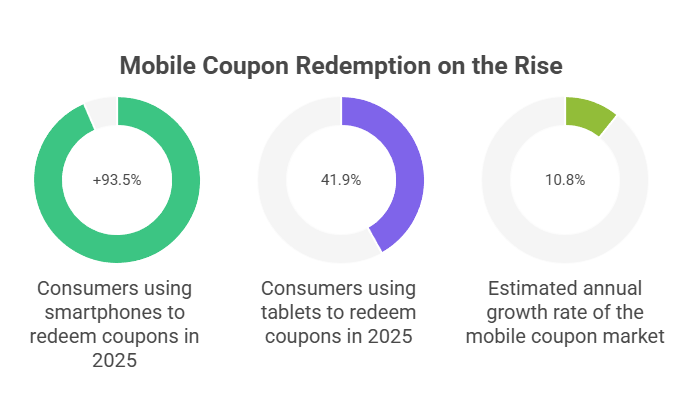
Smartphones are quickly becoming the dominant tool for coupon redemption. More than 9 out of 10 consumers are expected to use their smartphones to redeem a digital voucher or coupon in 2025.
This is a significant jump from previous years, where 85.5% of consumers used their mobile devices for this purpose. The convenience, speed, and integration with shopping apps and mobile wallets make smartphones the preferred platform for digital savings.
Coupon Usage on Smartphones and Tablets:
| Year | Coupon Usage On Smartphones | Coupon Usage On Tablets |
| 2020 | 85.5% | 42.4% |
| 2021 | 89.3% | 42.2% |
| 2022 | 91.5% | 42.2% |
| 2023 | 92.3% | 42.1% |
| 2024 | 93% | 42.0% |
| 2025* | 93.5% | 41.9% |
| 2026* | 93.8% | 41.9% |
*-projected values
The global mobile coupon market is flourishing, reaching $1.42 trillion in 2024, up from $1.12 trillion in 2023. This market is projected to almost double, reaching $2.9 trillion by the end of 2032, with an estimated annual growth rate of 10.8%.
This clearly indicates that mobile-first strategies are no longer optional for businesses; they are essential for engaging today’s digital-savvy consumer.
Digital vs. Paper: The Shifting Landscape
The debate between digital and paper coupons continues, but digital is winning. A 2023 survey found that 57% of shoppers favor digital coupons over paper ones, while 43% still prefer paper. More telling, nearly twice as many Americans use digital coupons via smartphone apps compared to those who rely on paper coupons from grocery store circulars.
Across generations, the preference for digital is clear:
Digital Coupon Users vs. Paper Coupon Users by Generation:
| Generation | Digital Coupons | Paper Coupons |
| Generation Z | 62% | 38% |
| Millennials | 70% | 30% |
| Generation X | 61% | 39% |
| Baby Boomers | 44% | 56% |
| Silent Generation | 11% | 89% |
Millennials and Gen Z are strongly digital, while Baby Boomers and the Silent Generation still lean towards paper. This highlights the need for businesses to offer both options to cater to a diverse customer base.
The Influence of Coupons on Shopping Behavior
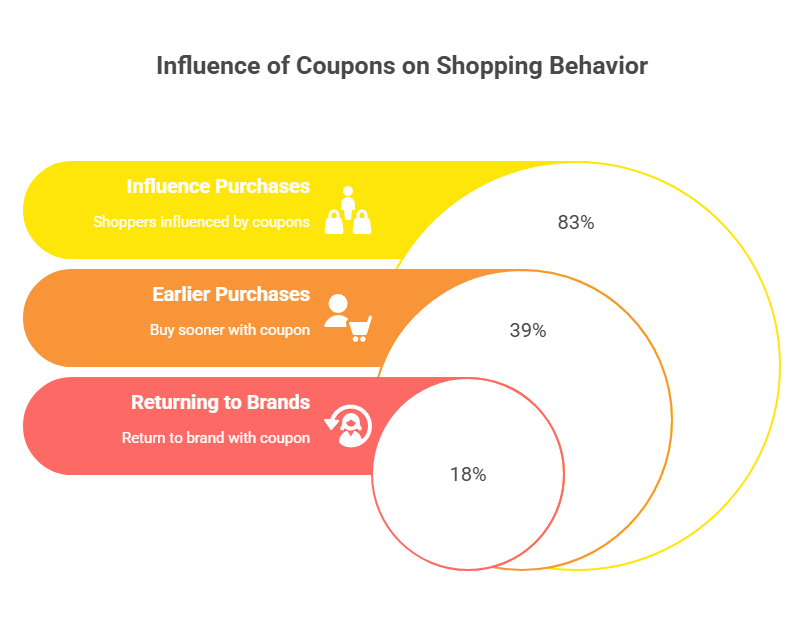
Coupons are not just about saving money; they are powerful motivators that change how we shop. An overwhelming 83% of shoppers report that coupons influence their purchasing decisions.
Here’s how coupons shape our shopping habits:
- Earlier Purchases: 39% of consumers buy a product sooner than planned because of a coupon.
- Trying New Brands: Coupons lead 39% of people to try a brand they would not have considered otherwise.
- Returning to Brands: 18% use coupons to return to a brand they had previously bought from, fostering customer loyalty.
- New Product Discovery: 19% of consumers are motivated to buy a new product after being influenced by a coupon or deal.
Social media also plays a significant role in inspiring purchases, with nearly half of U.S. consumers buying products after seeing them on social media. Coupon and deal websites also act as sources of inspiration.
Sources of Purchase Inspirations (Percentage of U.S. Shoppers):
| Sources of Purchase Inspirations | Percentage Of The Shoppers In The United States |
| Social media websites and apps | 46% |
| Friends and acquaintances | 44% |
| In the store | 43% |
| Search engines (e.g., Google) | 41% |
| Online stores | 37% |
| Video websites and apps (e.g., YouTube) | 34% |
| Customer reviews | 27% |
| Brand websites and apps | 25% |
| Coupon and deal websites and apps | 19% |
| Influencers/content creators | 19% |
| Magazines and newspapers | 16% |
When looking for product information, search engines like Google and Bing are the primary go-to sources (53%), but coupon and deal websites are also valuable, with 13% of consumers using them for product information.
Did You Know? Coupons play a major role in impacting the purchase decisions of consumers during Black Friday and Cyber Monday purchases, making those big shopping days even more about getting a deal!
Where Do People Find the Best Coupon Deals?
Several websites are leading the charge in helping consumers find coupons. Globally, Rakuten is the top coupon website, attracting 12.39% of all visits. Slickdeals.net is a close second, with nearly 10% of users.
Most Popular Coupon Websites Worldwide:
| Coupon Website | Share Of Visits |
| rakuten.com | 12.39% |
| slickdeals.net | 9.57% |
| capitaloneshopping.com | 8.22% |
| linksprf.com | 2.61% |
| joinhoney.com | 2.54% |
In the United States, Slickdeals.net takes the top spot, capturing 20.13% of traffic, followed closely by CapitalOneShopping.com.
Top 5 Coupon Websites in the United States:
- Slickdeals.net: 20.13%
- CapitalOneShopping.com: 17.16%
- Rakuten.com: 10.46%
- JoinHoney.com: 3.98%
- woot.com: 3.24%
Coupon aggregators are also popular, with Honey emerging as the most used among U.S. consumers in 2023 (29%). Rakuten and Swagbucks are also highly favored.
Leading Coupon Aggregators as of 2023:
| Coupon Aggregators | Percentage Of Consumers Regularly Using |
| Honey | 29% |
| RetailMeNot | 28% |
| Rakuten | 21% |
| Coupons.com | 21% |
| Swagbucks | 20% |
Social Media: A Hub for Coupon Discovery
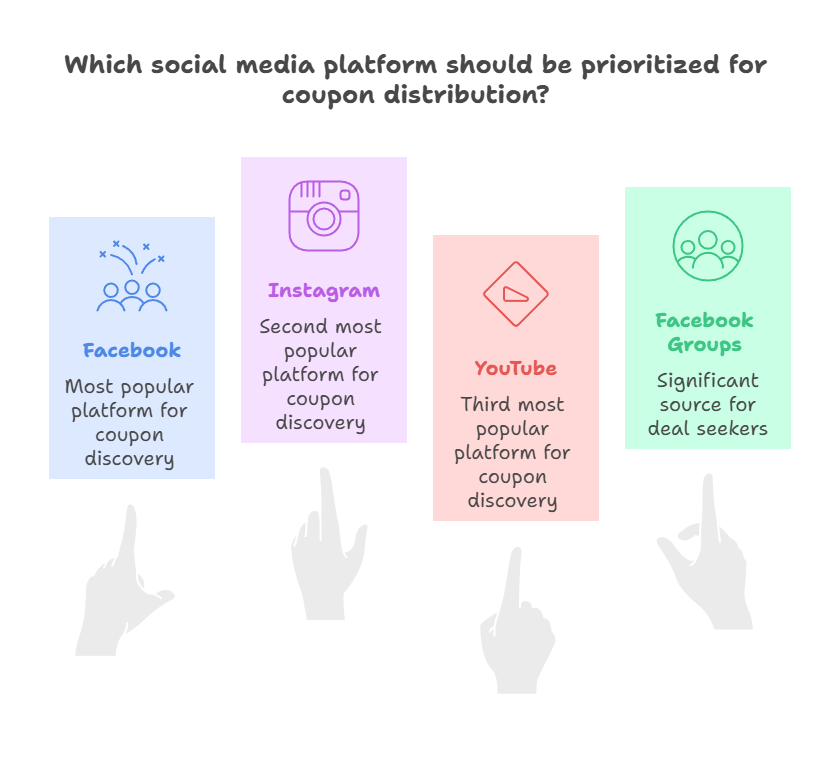
Social media platforms are increasingly important for finding discounts. Most consumers (42%) in the U.S. prefer using Facebook to find promo codes, discounts, and coupons. Instagram follows with 30%, and YouTube with 25%. Interestingly, Facebook Groups (18%) are also a significant source for deal seekers.
Social Media Platforms Used for Finding Coupons:
| Social Media Platform | Percentage Of Shoppers Using It To Find Coupons |
| 42% | |
| 30% | |
| YouTube | 25% |
| Facebook Groups | 18% |
| 14% | |
| 13% | |
| TikTok | 12% |
| 12% | |
| Snapchat | 8% |
| 6% |
These statistics highlight the diverse ways consumers interact with coupons, showing that businesses need a multi-channel approach to reach their audience effectively.
What Users Are Asking on Quora and Reddit (Latest Information):
Beyond the numbers, online communities like Quora and Reddit reveal evolving questions and discussions about coupons. Here’s what users are curious about:
- “Are those browser extension coupon finders reliable?” Many users are asking about the trustworthiness and effectiveness of browser extensions like Honey and Capital One Shopping. They want to know if these extensions genuinely find the best deals or if they sometimes miss out. The general consensus is that they are very helpful, but it’s always good to double-check against a dedicated coupon site for significant purchases.
- “How can I stack coupons for maximum savings?” Shoppers are increasingly looking for strategies to combine multiple discounts, like a store coupon with a manufacturer’s coupon, or a percentage-off deal with free shipping. Community members often share tips on store policies that allow coupon stacking and the best times to do it.
- “What’s the best way to get coupons for local businesses or smaller brands?” While major retailers often have widely available digital coupons, users are seeking advice on finding deals for local shops, restaurants, or emerging online brands. This often involves signing up for email newsletters directly from the businesses, following their social media, or looking for local deal aggregators.
- “Are printable coupons still relevant in 2025?” With the rise of digital, some users wonder if printing coupons is still a worthwhile effort. The data shows that for older demographics, paper coupons are very much relevant, and some smaller stores or specific brands still offer them. It really depends on your shopping habits and the type of store.
- “How do I deal with expired coupons or coupons that don’t work?” This is a common frustration, and users often share advice on checking expiration dates carefully, contacting customer service, or trying alternative coupon codes found in online communities. The success rate table above shows why this is a frequent topic.
These questions highlight a shift from simply finding coupons to optimizing their use and dealing with the practicalities of digital couponing.
FAQs About Coupon Statistics
1. Why have digital coupon redemption rates increased since 2008?
Digital coupon redemption rates have increased because technology makes them incredibly convenient and accessible, often available directly on smartphones and integrated with shopping apps, allowing consumers to easily find and use discounts instantly.
2. How much money can an average American household realistically save annually by using online coupons?
An average American household can realistically save as much as $1,465 annually by consistently using online coupons, with significant savings on groceries, household items, dining out, and entertainment.
3. What is the most effective way for me to find reliable digital coupons in 2025?
The most effective ways to find reliable digital coupons in 2025 include signing up for brand email newsletters, using popular coupon websites like Slickdeals.net and Rakuten, installing browser extensions like Honey, and following brands on social media platforms such as Facebook and Instagram.
4. How do coupons influence my purchasing decisions beyond just saving money?
Coupons influence your purchasing decisions by encouraging you to try new brands, buy products earlier than planned, return to brands you previously purchased, and even spend more than you originally intended because you feel smart getting a deal.
5. Are paper coupons still relevant for certain demographics or shopping scenarios in 2025?
Yes, paper coupons are still relevant in 2025, especially for older demographics like Baby Boomers and the Silent Generation who show a strong preference for them, and for specific shopping scenarios where local businesses or certain brands might exclusively offer them.
Also Read:
- Internet User Statistics
- Google Ads Statistics
- Tumblr Statistics
- Cryptocurrencies Statistics
- Threads Statistics
Conclusion:
It is clear: everyone loves a good deal, and coupons have become a fundamental part of our shopping experience. In 2025, around 93% of U.S. grocery shoppers actively use coupons, with a third of them increasing their frequency compared to 2023.
Smartphones are at the forefront of this trend, with 93.5% of consumers projected to redeem coupons via their mobile devices. Email marketing continues to be a powerful influence, guiding 47% of consumers to discover new deals.
The savings are substantial, with an average U.S. household potentially saving up to $1,465 annually. Shoppers overwhelmingly prefer “percentage-off” coupons (67%) and “buy one, get one free” offers (61%).
With the global digital coupon market projected to grow at an impressive CAGR of 18.33% and surpass $34 billion by 2032, coupons are not just a passing fad. They are a vital force driving both significant consumer savings and robust retailer sales growth. By understanding and actively using coupons, you empower yourself to shop smarter, save more, and make every purchase count.
